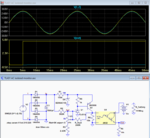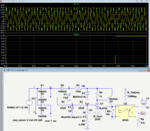crutschow
Advanced Member level 6
- Joined
- Feb 22, 2012
- Messages
- 4,454
- Helped
- 998
- Reputation
- 1,994
- Reaction score
- 1,121
- Trophy points
- 1,393
- Location
- Colorado USA Zulu -7
- Activity points
- 25,251
Addendum:
In my simulation the yellow traces are the 220Vac simulation results and the blue traces are the 210Vac simulation results.
In my simulation the yellow traces are the 220Vac simulation results and the blue traces are the 210Vac simulation results.

